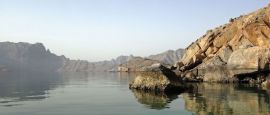Oman Weather, climate and geography
Weather & climate
Because Oman is so large and the terrain diverse, the climatic conditions are as varied as the geography. The most popular time to visit is from October to April when the weather is warm and sunny and temperatures range from a very pleasant 25°C (77°F) to around 35°C (95°F) during the day. It is cooler at night, ranging in temperature from 17°C (63°F) to 19°C (66°F).
From May to August, it is very hot and humid at the coastal areas, while the interior generally remains hot and dry. Between May and September, the southern Dhofar region has its own microclimate. Known as the khareef, the area catches the Indian Ocean’s monsoon season and temperatures can be 10-15°C (18-27°F) lower than the rest of the country. Most of the rain falls during the winter months and varies according to the region. Other than in Dhofar, it is rare to see rain between May and November. The coastal areas and the interior plains average 20-100mm (0.8-4 inches) of rainfall annually but this can rise to around 900mm (35 inches) in the mountains. It is common to see snowfall on the highest mountain peaks during the winter.
Lightweight cottons are advisable throughout the year, with a warm wrap for cooler winter evenings, mountain excursions and overworked air-conditioning in shops and restaurants. When touring, khaki or beige are more suitable colours to wear than white, as the dry, dusty conditions can discolour clothing.
Oman is a Muslim country and, while it is relatively moderate, visitors should be sensitive to its customs. Women should not bare shoulders or show low cleavage and should not wear short shorts or short skirts. Long shorts should ideally be below the knee. They should also carry a large scarf or pashmina with them at all times in case they need to cover their head. This is essential when visiting mosques. Men should only wear long, baggy shorts, and preferably trousers outside hotels. Swimming costumes are confined to hotel pools and beachwear should be modest. Most hotels do not require women to cover up when swimming, although women may choose to do so when bathing in the sea on public beaches.
Geography
The Sultanate of Oman occupies the southeastern edge of the Arabian Peninsula and a total area of 309,500 sq km (119,500 sq miles or roughly the same size as Italy) including the coastal islands of Masirah, Halanyat and Salama, plus Musandam and Madha, which are completely surrounded by the United Arab Emirates.
It is bordered by the Kingdom of Saudi Arabia to the northwest, the Republic of Yemen to the southwest and the United Arab Emirates to the north. Oman has 2,092 km (1,300 miles) of coastline on the Gulf, Arabian Sea and the Gulf of Oman. The interior is covered by a vast expanse of desert with around 82% of the landmass occupied by deserts and valleys. The Hajjar mountain range, which occupies around 15% of the country’s landmass, forms an arc extending from the northwest of the country to the southeast. The highest mountain is Jabal Shams, at around 2,980m (9,777ft).
Do you have any Feedback about this page?
© 2025 Columbus Travel Media Ltd. All rights reserved. No part of this site may be reproduced without our written permission, click here for information on Columbus Content Solutions.




 You know where
You know where